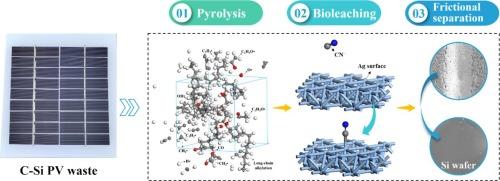A novel acid-free combined technology to achieve the full recovery of crystalline silicon photovoltaic waste
IF 7.1
2区 环境科学与生态学
Q1 ENGINEERING, ENVIRONMENTAL
引用次数: 0
Abstract
To achieve the global carbon neutrality commitment, photovoltaics, a clean and renewable source of energy, is increasingly deployed. Photovoltaic panels are core components of photovoltaic systems. As these panels reach the end of their life, recovering the photovoltaic waste becomes crucial. Currently, strong acid reagents are commonly used in the recovery of silver from crystalline silicon photovoltaic waste, posing environmental risks and restricting the industrialization of their recycling. In this study, a novel acid-free technology to achieve the full recovery of crystalline silicon photovoltaic waste was proposed. A pyrolysis process was first conducted for decapsulation, with carbon dioxide being the main gas component at 60.64 %. Next, bioleaching technology was employed to leach silver from waste crystalline silicon photovoltaic cells. The silver leaching rate in a single leaching cycle reached 44.7 %. Meanwhile, the mechanism of silver leaching was further analyzed. Finally, high-velocity fluid frictional separation, a technique that uses high-speed fluid flow to separate material, was chosen to obtain silicon wafers. The reclaimed silicon samples had a total thickness variation of 6.64 µm to11.62 µm, with average carrier lifetimes exceeding 4.9 µs, higher than that obtained by wet etching. This study is expected to advance the industrialization of the recovery of photovoltaic waste, which is also beneficial for the sustainable development of the photovoltaic supply chain.

实现晶体硅光伏废料完全回收的新型无酸组合技术
为实现全球碳中和承诺,光伏这一清洁的可再生能源正得到越来越多的应用。光伏板是光伏系统的核心部件。随着这些电池板使用寿命的结束,回收光伏废料变得至关重要。目前,从晶体硅光伏废料中回收银通常使用强酸试剂,不仅存在环境风险,还限制了其回收利用的产业化。本研究提出了一种新型无酸技术,以实现晶体硅光伏废料的全面回收。首先采用热解工艺进行脱胶,主要气体成分为二氧化碳,占 60.64%。接着,采用生物浸出技术从废弃晶体硅光伏电池中浸出银。在单次浸出循环中,银的浸出率达到 44.7%。同时,还进一步分析了银的浸出机理。最后,选择了高速流体摩擦分离技术(一种利用高速流体流动分离材料的技术)来获得硅片。回收的硅样品总厚度变化范围为 6.64 µm 至 11.62 µm,平均载流子寿命超过 4.9 µs,高于湿法蚀刻获得的平均载流子寿命。这项研究有望推动光伏废料回收的产业化,也有利于光伏供应链的可持续发展。
本文章由计算机程序翻译,如有差异,请以英文原文为准。
求助全文
约1分钟内获得全文
求助全文
来源期刊

Waste management
环境科学-工程:环境
CiteScore
15.60
自引率
6.20%
发文量
492
审稿时长
39 days
期刊介绍:
Waste Management is devoted to the presentation and discussion of information on solid wastes,it covers the entire lifecycle of solid. wastes.
Scope:
Addresses solid wastes in both industrialized and economically developing countries
Covers various types of solid wastes, including:
Municipal (e.g., residential, institutional, commercial, light industrial)
Agricultural
Special (e.g., C and D, healthcare, household hazardous wastes, sewage sludge)
 求助内容:
求助内容: 应助结果提醒方式:
应助结果提醒方式:


